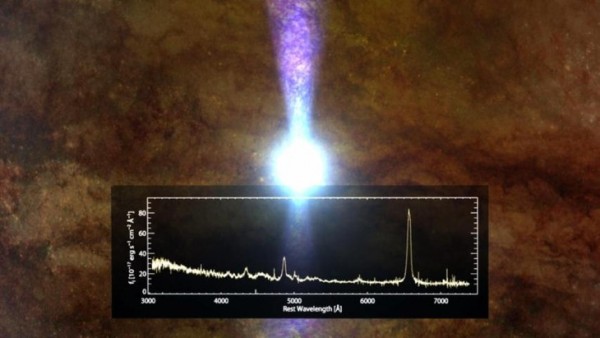By Ana Verayo, | January 11, 2016

The image shows an artist's conception of the "changing-look quasar" as is appeared in early 2015. The glowing blue region shows the last of the gas being swallowed by central black hole as it shuts off. The spectrum is the previous one obtained by the SD
Scientists revealed that a quasar has now ran out of fuel when its black hole sucked all its stellar gas, making it disappear.
Researchers from the Sloan Digital Sky Survey (SDSS) have been observing this quasar also known as SDSS J1011+5442 for almost 10 years, where its black hole core has been absorbing star fuel that was keeping the star shining bright.
Like Us on Facebook
According to astrophysicist Michael Eracleous from Pennsylvania State University, the quasar emission over the past 12 years was remarkable and stunning due to these changes. Eracleous says that the luminosity of the quasar's gas declined over 50 and if the first observations were taken today, scientists would identify it as a regular galaxy with no hints that it hosted a supermassive black hole in its core.
Back in 2003, the SSDS's Time-Domain Spectroscopic Survey detected this quasar, making the survey's first major finding and during the dying star's final stages, scientists obtained observations of a 50 fold dip in its overall brightness.
According to principal investigator of TDSS, Scott Anderson of the University of Washington, everyone have been used to thinking that the sky is unchanging where the SDSS provides a remarkable glimpse of crucial changes in our universe. This quasar was only discovered since the team wanted to study thousands of similar quasars already discovered, he adds.
In this new study, scientists consider this the first time to observe a quasar die so dramatically and quickly, according to Jessie Runnoe from the Pennsylvania State University. Runnoe says that the quasar essentially ran out of food, at least for the moment, where the team is fortunate enough to capture it before and after.
On the other hand, NASA also revealed that their Chandra X-ray Observatory also observed a "burping" supermassive black hole, releasing powerful X-ray emissions from the dwarf galaxy, NGC 5195. New findings showed evidence that black holes not only destroy cosmic objects and devour stars, light and dust, but they can also "burp" some of these emissions, according to lead author of the study, Eric Schlegel of the University of Texas in San Antonio.
Schlegel adds that these burping emissions from black holes are crucial in understanding the early evolution of stars and galaxies when the universe is just forming, spewing crucial stellar material that are important for making new stars.
-
Use of Coronavirus Pandemic Drones Raises Privacy Concerns: Drones Spread Fear, Local Officials Say

-
Coronavirus Hampers The Delivery Of Lockheed Martin F-35 Stealth Fighters For 2020

-
Instagram Speeds Up Plans to Add Account Memorialization Feature Due to COVID-19 Deaths

-
NASA: Perseverance Plans to Bring 'Mars Rock' to Earth in 2031

-
600 Dead And 3,000 In The Hospital as Iranians Believed Drinking High-Concentrations of Alcohol Can Cure The Coronavirus

-
600 Dead And 3,000 In The Hospital as Iranians Believed Drinking High-Concentrations of Alcohol Can Cure The Coronavirus

-
COVID-19: Doctors, Nurses Use Virtual Reality to Learn New Skills in Treating Coronavirus Patients







